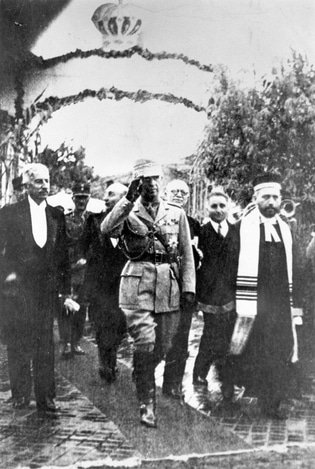This is the weekly column of David Shasha in eSefarad.
The following article was published in the Sephardic Heritage Udate #581
The Betrayal of Salonica’s Jews
By: Andrew Apostolou
Andrew Apostolou is a historian based in Washington D.C.
From Jewish Ideas Daily, April 18, 2013
Here is a very interesting article that attempts to conceal more than it reveals.

Belongs to collection: Yad Vashem Photo Archive
Origin: Encyclopedia of the Holocaust – Hebrew Edition 1990
An important element in the Nazi destruction of Salonica’s Jewish community was the participation of Rabbi Zvi Koretz in the deportations to the Death Camps.
The story is detailed in the following entry in the Jewish Virtual Library:
http://www.jewishvirtuallibrary.org/j source/Holocaust/sephardimsalonica.html
As the article states:
“The Final Solution started in Greece in February 1943, with the arrival of two prominent Nazi officials, Dieter Wisliceny (a close aide to Adolph Eichmann who supervised many deportations) and Alois Brunner. When the two arrived in Salonica, they immediately enacted anti-Jewish measures, and Koretz counciled the community to abide by them. In contract to the chief rabbi in Athens, Elias Barzilai, who was a Sephardic Jew, encouraged his community to flee, Koretz told Jews they would be safely resettled in Poland and would eventually find work elsewhere, according to some historical accounts.”
Further details are provided in the entry on the Judenrat in the Holocaust Research Project:
http://www.holocaustresearchproject.org/ghettos/judenrat.html
Ironically, Rabbi Koretz was himself deported to Bergen-Belsen though he survived the war only to die of typhus in 1945 during the post-war transport of refugees.
So while it is certainly true that Greek Christians were very willing assistants to the Nazis, it should be remembered that the newly-installed Ashkenazi Rabbi Koretz worked as part of the Judenrat scheme as an enabler of the Nazi genocide and has been remembered by the Sephardim of Salonica for his disastrous role in this tragedy.
It appears that this article published by Jewish Ideas Daily has chosen to ignore the important role of Rabbi Koretz in the destruction of the Salonican Jewish community. It is quite curious that unlike most discussions of the Holocaust in Salonica, Mr. Apotolou has left out the name of Rabbi Koretz from his analysis of the matter.
DS
The Nazis’ mass deportations of Jews from Greece in 1943 and 1944 largely ended the life of a thriving community, one responsible for centuries of important contributions to Jewish culture and to the life of the land in which the community lived. Eighty-six percent of Greece’s prewar Jewish population perished. In Salonika, where 70 percent of Greek Jews lived, the death rate exceeded 90 percent. While the German campaign to kill the Jews is no secret, few in Greece acknowledge that the Germans had the support of Greek administrators and police.
Greece’s political leaders have paved the way for this unwillingness to confront Greek collaboration in the Holocaust. Prime Minister Antonis Samaras recently spoke of the Holocaust as if it happened in Greece by chance and as if Greek non-Jews were utterly uninvolved.
Yet the Germans succeeded in their nefarious work precisely because Greek non-Jews were willing to assist. The German occupiers of Salonika implemented their standard battery of anti-Semitic measures with consistent support from Greek Christian administrators, civil servants, and police. The Germans systematically impoverished, isolated, marked, ghettoized, and then deported the Jews. The number of German officials directly involved in deporting tens of thousands of Salonika Jews to Auschwitz in 1943 was relatively small, because the local Greek authorities cooperated and contributed their own manpower.
Salonika is central to the history of the Holocaust in Greece because it had a Jewish identity that many Greeks wanted to erase. Thousands of Jews fleeing from Spain and Portugal (together, Sepharad in Hebrew) had revived the city in the late 15th century. The Sephardim soon became a majority in Salonika, turning the city, then under Ottoman rule, into a major Jewish religious and cultural center. When Greek troops captured Salonika in 1912, they found a city in which the main language was Ladino, not Greek. Although the Jews were anxious about Greek rule, they adjusted, and the younger generations learned the Greek language. By the eve of World War II, the Jews were no longer a majority of the city’s inhabitants, but they had every reason to believe that they were Greeks and that Greece was their country.
The feeling was not reciprocated by many of Salonika’s Christians, and the arrival of the Germans in 1941 provided them with their opportunity. The character of Salonika had changed in the 1920s after a large influx of Greek Christian refugees from Turkey. The Greek government promoted the city’s Greek identity, even discouraging the use of shop signs in Ladino. The Greek press in the city was often viciously anti-Jewish, inciting a 1931 pogrom that claimed two lives. When the Germans entered Salonika on April 6, 1941, they found a willing cadre of collaborators and a broad section of Greek Christian opinion hostile to the Jews.
Local Greek anti-Semites volunteered their services to the Germans, helping them publish two propaganda newspapers that vilified the Jews. On April 21, 1941, the day after Hitler’s birthday, Greek Christian collaborators put up signs in Greek and German declaring “Jews unwelcome in this shop.” This was the first appearance of such notices in Greece. The German occupation authorities, who were not yet ready for such measures, halted the campaign.
Equally useful to the Germans was the accommodating attitude of the Greek administration in Salonika. Government officials and police commanders in Salonika complied with German orders and even showed some initiative. A figure central to the implementation of Nazi measures was Vassilis Simonides, the administrator for northern Greece, who was based in Salonika. Simonides was an economist with no overt ideological leanings, but he frequently did more than just translate and circulate German orders.
When the German military decided on a mass call-up of Jewish men in Salonika for forced labor in July, 1942, Simonides issued a proclamation specifying that the measure applied to men of the Jewish “race,” regardless of their religion. While this was consistent with Nazi racism, it was the first time that Greece had ever defined Jews by race. The Greek police and the Salonika municipality participated in registering close to 9,000 Jewish men, while German soldiers and sailors beat and humiliated them. The Greek police then marched the men away to work on German military projects that were supervised by Greek engineers. Demobilized Greek military officers watched over the Jewish laborers, sometimes contributing their own abuse to that of the Germans.
The relationship between the Nazi occupiers and their Greek counterparts was so good that the Germans were willing to trust the Greeks with sensitive information. In January, 1943, the Germans provided the Greek collaborationist government in Athens with close to two months’ warning of the deportations. Günther Altenburg, the de facto German ambassador, met with the collaborationist prime minister, Constantine Logothetopoulos, to inform him of the impending expulsion of the Greek Jews to Poland. After their discussion, Altenburg told Berlin to expect “no difficulties” from Logothetopoulos.
Instead of raising the alarm, the Greek authorities used their advance notice to push through German measures designed to isolate the Salonika Jews. Throughout February and March of 1943, the Greek authorities in Salonika implemented German orders that expelled Jews from public bodies and associations, forced Jews to wear the yellow star, and barred Jews from public transportation. The Greek administration helped the Germans confine the Jews to two main ghettos, which had never before existed in Salonika, and set Greek police guards around them.
The process of assisting in the deportations followed directly from these other initiatives. On March 15, 1943, the Greek police marched Jews to the Salonika railway station. Eighteen trains, supplied by the Greek railways, took 45,324 Jews to Auschwitz. Upon their arrival, the Germans sent most of them to the gas chambers. By the end of the war there were just 2,000 Jews in Salonika.
Greek officials also initiated their own measures against Jews. During the spring of 1943, Italian consular officials issued protection papers to 75 Salonika Jews with apparent ties to Italy. The Germans could not respond aggressively to their Italian ally’s behavior; the Greek authorities also needed to be careful, since Italy, along with Germany, was an occupying power in Greece and could retaliate. Nevertheless, Greek officials confiscated the protective documents. The Germans then arrested the Jews and deported them.
By late 1944, as the war was entering its closing stages and the Germans were preparing to leave Greece, just 13 Jews were known to be in Salonika. The Red Cross, bribes, and in one case an American passport saved five of these Jews. Greek collaborators shot the remaining eight on September 8, 1944.
The standard explanation for this kind of behavior is that defying the Germans was dangerous, with the danger forcing the collaborators to comply with Germans orders. This overlooks the fact that Greek collaborators and ordinary citizens in Salonika opposed German actions on numerous occasions, often taking considerable risks. But very few were willing to engage in such heroics for the Salonika Jews.
—————————————————————————————————————-
 by David Shasha to eSefarad.
by David Shasha to eSefarad.
Copyright David Shasha & eSefarad all rights reserved
Copyright David Shasha & eSefarad todos los derechos reservados.
David Shasha is the founder and director of the Center for Sephardic Heritage in Brooklyn, New York designed to raise awareness of the history and culture of Arab Jews. He publishes the Sephardic Heritage Update, a weekly e-mail newsletter available on Google Groups. He has written for publications such as the Huffington Post, Tikkun magazine, The Progressive Christian, and The American Muslim. You can contact him at david.shasha.shu@gmail.com
 eSefarad Noticias del Mundo Sefaradi
eSefarad Noticias del Mundo Sefaradi


A tragédia que se abateu sobre os judeus de Salônica deve servir de exemplo para que as coletividades judaicas não sigam cegamente o que determinem suas lideranças, sejam elas religiosas ou laicas. Agora, atribuir ao fato do Rabino que traiu, de forma vergonhosa, aquela sofrida coletividade ser asquenazi, além de injusta, peca pelo primarismo. Não é por ser judeu ou não-judeu, sefaradi ou asquenazi, que alguém se comporta como herói ou oportunista. Nelson Menda
Very well said.
What happened in Salonika was a tragedy of global proportion. There are certain events in life impossible to apologize for. This is one of them. The cries of the innocent will continue to vibrate corridors of this Universe into eternity. There is no amount of time and no amount of silence that can erase the pain and the injustice permitted by the majority. It is inexcusable that we sit in silence while human beings are sent to their graves by criminal minds. Congratulations to you for writing the truth. May your courage be rewarded with divine wisdom and abundant blessing. How many were identified by race alone, and not by religion. And were hunted down like dangerous animals. To be subjected to the worst humiliation possible . As complete as the lists may be, there are many more that are not on the lists. May their souls find everlasting peace and may their spirits shine with brilliant light upon their eternal ressurection . The Holocaust of Salonika was a Holocaust of our Humanity. And the attempted silence by some is a second Holocaust. Evan P.